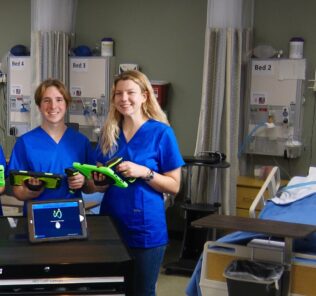Escape Rooms in Medical Simulation: Downloadable Sepsis Scenario & More
Have you ever tried an Escape Room? How about an Escape Room of Medical Simulation? Human factors such as effects of teamwork, tasks, equipment, workspace, culture and organization are increasingly being shown to affect patient outcomes. Escape Rooms are perfect opportunities for teams that have never met before (or even better if they have) and asks them to quickly solve under time pressure the uniquely random sets of (hopefully) solve-able problems — albeit strictly for fun! Imagine we could combine a healthcare simulation learning scenario, from the framework of an “Escape Room”? Today Dr. Kim Baily PhD, MSN, RN, CNE, previous Simulation Coordinator for Los Angeles Harbor College and Director of Nursing for El Camino College helps us do just that!
(Editors Note: HealthySimulation.com and Dr. Baily wish to thank Nichole Holte BS, RN, CHSE and her colleagues at Essentia Health, Fargo, ND for sharing their detailed 8 page sepsis escape room simulation scenario shared below!)
Human factors research also aids in understanding why errors occur, when errors might occur in the future and how systems can be redesigned to prevent errors. Medical education for physicians, nurses, pharmacists and other allied disciplines must include human factors as part of their curricula. Creating effective teaching strategies to improve communication and teamwork is challenging.
Sponsored Content:
Traditional classroom teaching remains the most common method in healthcare education however, this may leave the learner with inadequate soft skills. Experiential learning strategies, such as simulation, have been shown to enhance communication and teamwork skills. More recently, gaming and in particular escape room activities have been introduced as a learning strategy to enhance soft skills. The goal of gaming strategies is to create a fun and engaging environment that incorporates soft skills such as teamwork. This article reviews four recent studies related to the use escape rooms in medical education.
What is an Escape Room?
An escape room, aka an escape game, is a fun event in which a team of players cooperatively discover clues, solve puzzles, and accomplish tasks in one or more rooms in order to progress and accomplish a specific goal in a limited amount of time. The goal is often to escape from the site of the game. Escape rooms became popular in North America, Europe and East Asia in the 2010s. Rooms look (or simulate) a time and place from the old west to the future of space, and found clues come together to solve the puzzles and unlock the door (which is never really locked in case of real emergency). This video sums them up just fine:
Sponsored Content:
Non Medical Escape Room Experience Helps ED Doctors
In a recent study by Zhang et al. (2018), ten ED residents and faculty participated in a commercial escape room which was available to the general public and which had no connection with any medical institution. No roles were assigned and the team had 60 minutes to “escape” from the room. To escape the room, participants had to practice teamwork, communication, task-delegation, critical thinking, and divergent thinking to tackle a series of increasingly complex puzzles, ranging from hidden objects, physical object assembly (i.e., jigsaw puzzles), counting, and/or symbol matching.
The investigators used an 18 question validated, post-study survey evaluation adapted from a post-focus group interview guide to obtain written feedback about the escape room activity. Nine out of 10 participants thought the escape room mimicked an ED in that the experience involved co-managing stressful situations, settling differences in opinion, and providing periodic status updates. Half of the participants would have preferred a more structured debriefing, similar to a debriefing following a simulation. (Zhang X, Lee H, Rodriguez C, et al. (March 02, 2018) Trapped as a Group, Escape as a Team: Applying Gamification to Incorporate Team-building Skills Through an ‘Escape Room’ Experience. Cureus 10(3): e2256. doi:10.7759/cureus.2256).
A Suitcase Escape Room:
The British Medical Journal Education Improvement Report entitled Escape into patient safety: bringing human factors to life for medical students by Blackhouse and Malik described an escape room in which learners solved a series of clinical and communication-based tasks in order to treat a fictional patient while avoiding ‘clinician error’. This escape room is easily portable since all the clues and props are contained within a suitcase. Students must complete a series of clinical tasks: making a diagnosis; calculating a National Early Warning Score (NEWS); looking up treatment in the British National Formulary; completing a drug chart to prescribe medication within 30 minutes.
The escape is obtained when the patient is treated appropriately without harm. The escape room is followed by an After Action Review (AAR) which allows students to reflect as a group on their experience, explore factors which led to a successful or not so successful completion of the game and reflect on the role of human factors on the outcome. All of the students agreed that they gained new knowledge and skills and insights and felt confident that they would be able to apply what they had learnt in the future. (http://dx.doi.org/10.1136/bmjoq-2018-000548).
Escape Room and Simulation Combined:
The third article by Brown, Darby and Coronel involved the use of an “escape room” within a high fidelity simulation. Rather than using an escape room, the “escape” involved determining the combination of a series of four locks on boxes which allowed the learners to progress through a urosepsis simulation within 60 minutes (Brown, N., Darby, W., & Coronel, H. (2019, May). An escape room as a simulation teaching strategy. Clinical Simulation in Nursing, 30(C), 1-6).
Note, the boxes came from a company called Breakout EDU which sells “breakout” EDU kits and offers an immersive learning game platform which is adaptable to any subject or grade level. Initially, goals and learning objectives were created for the simulation and escape room. Learners reported that the addition of an escape room contributed to their learning and their ability to delegate tasks and function as part of a team.
Escape Room for Hospital Staff
The last article was created by two RNs Gabriel and Lieb in an effort to create a fun learning experience for hospital staff on World Sepsis Day at Penn Medicine Sepsis Alliance. Staff from various disciplines such as social workers, physical therapists, physicians, nursing assistants, nursing students, and nurses volunteered to participate in the escape room. The staff had 25 minutes to solve four puzzles and interpret clues to detect and treat sepsis in a mock patient before they could escape.
One puzzle related to administration of IV antibiotic therapy. The room had an IV pump set up with four antibiotics that were tangled together and the patient only had two working IVs. Faculty debriefed each team of 6-7 staff members. Post escape room evaluations confirmed that staff had a better understanding of sepsis and the availability of sepsis tool kits available at the hospital. The escape room was so popular that additional sessions were offered.
Download the Sepsis Escape Room Scenario Here!
Only 13% of students enrolled in a baccalaureate nursing program are over the age of 30 years of age (NLN survey). Since millennial students are strongly connected to technology and gaming, escape rooms could make a good strategy for engaging learners. More research needs to be done to determine the effectiveness of escape rooms as a learning methodology and to compare the cost of escape rooms with more traditional simulation.
Learn More About an Escape Room Sim for Sepsis!
Have a story to share with the global healthcare simulation community? Submit your simulation news and resources here!
Dr. Kim Baily, MSN, PhD, RN, CNE has had a passion for healthcare simulation since she pulled her first sim man out of the closet and into the light in 2002. She has been a full-time educator and director of nursing and was responsible for building and implementing two nursing simulation programs at El Camino College and Pasadena City College in Southern California. Dr. Baily is a member of both INACSL and SSH. She serves as a consultant for emerging clinical simulation programs and has previously chaired Southern California Simulation Collaborative, which supports healthcare professionals working in healthcare simulation in both hospitals and academic institutions throughout Southern California. Dr. Baily has taught a variety of nursing and medical simulation-related courses in a variety of forums, such as on-site simulation in healthcare debriefing workshops and online courses. Since retiring from full time teaching, she has written over 100 healthcare simulation educational articles for HealthySimulation.com while traveling around the country via her RV out of California.
Sponsored Content:



















